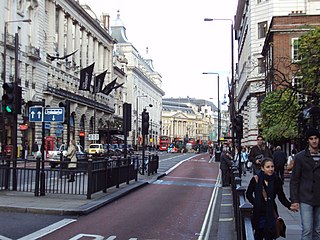
Piccadilly is a road in the City of Westminster, London, to the south of Mayfair, between Hyde Park Corner in the west and Piccadilly Circus in the east. It is part of the A4 road that connects central London to Hammersmith, Earl's Court, Heathrow Airport and the M4 motorway westward. St James's is to the south of the eastern section, while the western section is built up only on the northern side. Piccadilly is just under 1 mile (1.6 km) in length, and it is one of the widest and straightest streets in central London.
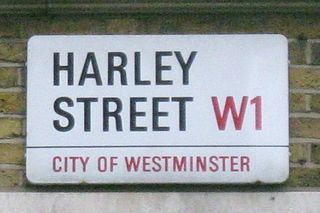
Harley Street is a street in Marylebone, central London, which has been noted since the 19th century for its large number of private specialists in medicine and surgery. It was named after Thomas Harley who was Lord Mayor of London in 1767.

Ye Olde Cheshire Cheese is a Grade II listed public house at 145 Fleet Street, on Wine Office Court, City of London. Rebuilt shortly after the Great Fire of 1666, the pub is known for its literary associations, with its regular patrons having included Charles Dickens, G.K. Chesterton and Mark Twain.

The Radium Girls were female factory workers who contracted radiation poisoning from painting watch dials with self-luminous paint. The painting was done by women at three different factories, and the term now applies to the women working at the facilities: one in Orange, New Jersey, beginning around 1917; one in Ottawa, Illinois, beginning in the early 1920s; and a third facility in Waterbury, Connecticut.

Cottingham is a large village and civil parish in the East Riding of Yorkshire, England with slightly above average affluence. It lies just north-west of the city of Kingston upon Hull, and 3.5 miles (5.6 km) from the city centre, and is part of the Hull urban area. Cottingham lies on the eastern edge of the Yorkshire Wolds with a parish population of over 17,000 in 2011. Cottingham is one of the villages claiming to be the largest village in England.
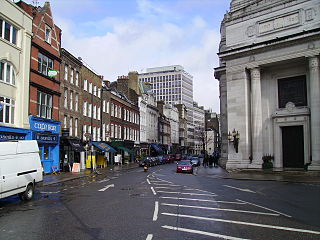
Great Queen Street is a street in the West End of central London in England. It is a continuation of Long Acre from Drury Lane to Kingsway. It runs from 1 to 44 along the north side, east to west, and 45 to about 80 along the south side, west to east. The street straddles and connects the Covent Garden and Holborn districts and is in the London Borough of Camden. It is numbered B402.
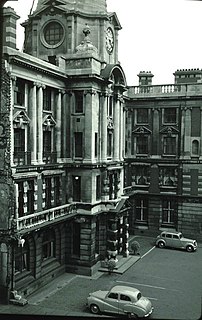
Manchester Royal Infirmary is a hospital in Manchester, England, founded by Charles White in 1752. It is now part of Manchester University NHS Foundation Trust, sharing buildings and facilities with several other hospitals.
The Christie NHS Foundation Trust in Withington, Manchester, manages the Christie Hospital, one of the largest cancer treatment centres of its type in Europe. The Christie became a NHS Foundation Trust in 2007 and is also an international leader in cancer research and development, home to the Paterson Institute for Cancer Research.

Horace Trumbauer was a prominent American architect of the Gilded Age, known for designing residential manors for the wealthy. Later in his career he also designed hotels, office buildings, and much of the campus of Duke University. Trumbauer's massive palaces flattered the egos of his "robber baron" clients, but were dismissed by his professional peers. His work made him a wealthy man, but his buildings rarely received positive critical recognition. Today, however, he is hailed as one of America's premier architects, with his buildings drawing critical acclaim even to this day.
The Borough Compter was a small compter or prison initially located in Southwark High Street but moved to nearby Tooley Street in 1717, where it stood until demolished until 1855. It took its name from 'The Borough', a historic name for the Southwark area of London on the south side of the River Thames from the City of London. This replaced a lock-up as part of the City's court house under the jurisdiction of the Lord Mayor and Court of Aldermen of the City, and their High-Bailiff of Southwark. This first court house was converted from the old parish church of St Margaret's. A floor was made across the level of the church's gallery and the windows below that were blocked in, the Court Room being on the first floor. This structure was destroyed in the Great Fire of Southwark in 1676.
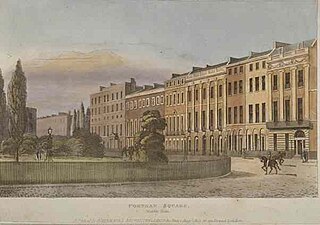
Portman Square is a garden square in Mayfair, central London, surrounded by elegant townhouses. It was specifically for private housing let on long leases having a ground rent by the Portman Estate, which owns the private communal gardens. It marks the western end of Wigmore Street, which connects it to Cavendish Square to the east.

Beehive Mill is a Grade II* listed former cotton mill in the district of Ancoats, Greater Manchester, England. It is located at on a site surrounded by Radium Street, Jersey Street, Bengal Street and Naval Street.

Mansfield Brewery was a brewery and public house operating company, based in the North Nottinghamshire market town of Mansfield, England. Established in 1855, after being taken over by Wolverhampton & Dudley Breweries in 1999, the brewing of the branded beers was moved to Wolverhampton in 2002, where it continues today under the control of Marston's. The former brewery site was until 2018 still vacant awaiting redevelopment. A section previously used informally as an articulated-lorry trailer park was refused retrospective planning consent in late August 2015. Work started in 2019 to transform the brownfield site into a mixed residential development.

Harry S. Fairhurst was a prominent architect in Edwardian Manchester. He was responsible for many of the city's iconic warehouses and his commissions include Blackfriars House, headquarters of the Lancashire Cotton Corporation and Arkwright House, headquarters of the English Sewing Cotton Company.
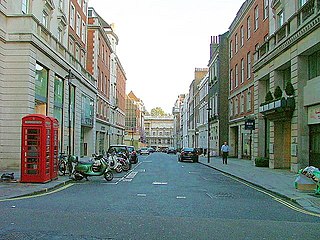
Sackville Street is a street in central London which today is mainly composed of offices and the rears of retail premises, but once was the home to several important medical figures.

The Old Bell is a Grade II listed public house at 16 Exeter Street and 23 Wellington Street, Covent Garden, London, WC2.
Mark Masons' Hall in London is the headquarters of The Grand Lodge of Mark Master Masons of England and Wales, which is also responsible for the Royal Ark Mariner degree. It is located in 86 St James's Street in the central London district of St James's, opposite St James's Palace. While Freemasons' Hall is the headquarters of the United Grand Lodge of England and the Supreme Grand Chapter of Royal Arch Masons of England, Mark Masons' Hall is the home of several other important appendant orders of Freemasonry in England and Wales.

Riding House Street is a street in central London in the City of Westminster.
Frederick Woodward Branson, FIC, FCS was a British chemist, glassblower, instrument maker and X-ray pioneer.

Hyde Park Square is a residential, tree-planted, garden square one block north of Hyde Park fronted by classical buildings, many of which are listed and marks a crossover of Lancaster Gate and Connaught Village neighbourhoods of Bayswater, London. It measures (internally) 200 by 500 feet, of which the bulk is the private communal garden – the rest is street-lit, pavemented streets with low railings in front of the houses.
















